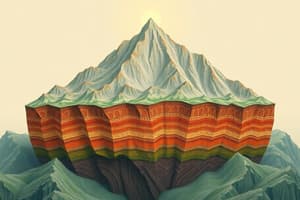Podcast
Questions and Answers
What is the thickness of tectonic plates?
What is the thickness of tectonic plates?
- 10-20 km
- 100-200 km
- 50-100 km (correct)
- 200-300 km
What is the driving force behind the movement of tectonic plates?
What is the driving force behind the movement of tectonic plates?
- Convection currents in the mantle (correct)
- Ocean currents
- Wind
- Gravity
What type of plate boundary is characterized by plates moving apart?
What type of plate boundary is characterized by plates moving apart?
- Continental
- Divergent (correct)
- Convergent
- Transform
What is the result of the process of subduction?
What is the result of the process of subduction?
What is the result of the process of sea-floor spreading?
What is the result of the process of sea-floor spreading?
What is the term for the interaction between two continental plates resulting in mountain formation?
What is the term for the interaction between two continental plates resulting in mountain formation?
What is the term for volcanic activity at fixed points, creating island chains?
What is the term for volcanic activity at fixed points, creating island chains?
What is the role of tectonic plates in shaping the Earth's surface?
What is the role of tectonic plates in shaping the Earth's surface?
What is the significance of tectonic plates in understanding the Earth's internal dynamics?
What is the significance of tectonic plates in understanding the Earth's internal dynamics?
At convergent boundaries, two plates move apart from each other.
At convergent boundaries, two plates move apart from each other.
The San Andreas Fault in California is an example of a divergent boundary.
The San Andreas Fault in California is an example of a divergent boundary.
Earthquakes are common at plate boundaries.
Earthquakes are common at plate boundaries.
Seafloor spreading is a characteristic of convergent boundaries.
Seafloor spreading is a characteristic of convergent boundaries.
Transform boundaries are characterized by the creation of new crust.
Transform boundaries are characterized by the creation of new crust.
The Andean mountain building is an example of a divergent boundary.
The Andean mountain building is an example of a divergent boundary.
Plate boundaries can be only a few kilometers wide.
Plate boundaries can be only a few kilometers wide.
At divergent boundaries, new ______ is created as magma rises to fill the gap.
At divergent boundaries, new ______ is created as magma rises to fill the gap.
At convergent boundaries, one plate can be forced under another, a process known as ______.
At convergent boundaries, one plate can be forced under another, a process known as ______.
The Mid-Atlantic Ridge is an example of a ______ boundary.
The Mid-Atlantic Ridge is an example of a ______ boundary.
The Himalayan orogeny is an example of a ______ boundary.
The Himalayan orogeny is an example of a ______ boundary.
At transform boundaries, two plates ______ past each other horizontally.
At transform boundaries, two plates ______ past each other horizontally.
Mountain building occurs at ______ boundaries where plates collide and crumple.
Mountain building occurs at ______ boundaries where plates collide and crumple.
Study Notes
What are Tectonic Plates?
- Large, rigid slabs of the Earth's lithosphere (outer layer)
- Fit together like a jigsaw puzzle
- In constant motion, sliding over the more fluid asthenosphere (upper mantle)
Characteristics of Tectonic Plates
- Thickness: 50-100 km
- Composition: oceanic crust, continental crust, or a combination of both
- Boundaries: where plates meet and interact
- Movement: 2-10 cm/year, driven by convection currents in the mantle
Types of Plate Boundaries
- Divergent: plates move apart, new crust forms
- Examples: Mid-Atlantic Ridge, East African Rift System
- Convergent: plates collide, crust is destroyed or deformed
- Examples: Himalayan orogeny, Andean mountain building
- Transform: plates slide past each other horizontally
- Examples: San Andreas Fault, North Anatolian Fault
Plate Interaction and Processes
- Subduction: denser plate is forced beneath another plate
- Continental collision: two continental plates collide, forming mountains
- Sea-floor spreading: new oceanic crust is created at mid-ocean ridges
- Hotspots: volcanic activity at fixed points, creating island chains (e.g., Hawaiian Islands)
Importance of Tectonic Plates
- Shape the Earth's surface, creating mountains, volcanoes, and earthquakes
- Influence climate, ocean currents, and the formation of natural resources
- Essential for understanding geological history and the Earth's internal dynamics
Studying That Suits You
Use AI to generate personalized quizzes and flashcards to suit your learning preferences.
Description
Learn about the characteristics, types, and interactions of tectonic plates, including divergent, convergent, and transform boundaries. Understand the processes of subduction, continental collision, sea-floor spreading, and hotspots.




